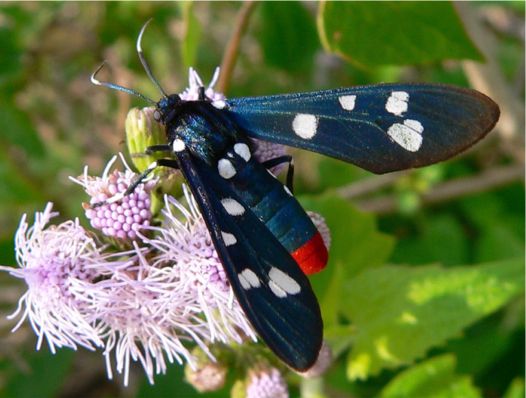Return
to Texas Entomology - Compiled by Mike
Quinn
Polka-dot Wasp Moth
Syntomeida epilais (Walker, 1854)
Tiger Moth Family Arctiidae
(nectaring on Eupatorium azureum -
Asteraceae)
Falcon
State Park
Falcon Heights, Starr County, Texas
March 2-3, 2008 (Frances Bartle)
Found by Don DeSteiguer, the moth was present for two days,
both of which were excessively windy.
Range:
Common throughout the Florida peninsula. Present along the Georgia, South
Carolina and Mississippi Coasts.
Grand Bay Nat'l Wildlife Refuge,
Jackson Co., Moss
Point, Mississippi, 20-IX-2003, STATE RECORD
Charleston Co., James
Island, South Carolina, 30-X-2005, STATE RECORD
Per Knudson & Bordelon (2004), "This species is vaguely reported
from the [Rio Grande] Valley, but we have not seem an authentic specimen."
Bratley (1932) (and others) reports its range extending from northern South
America, through Central America into Mexico, and from many Caribbean islands.
Bratley cited Biologia Centrali-Americana as listing collection locations for
this moth from northern South America, however the BCA
only mentions Mexico and Belize for Syntomeida epilais. Also,
significantly, Janzen & Hallwachs' (2005) database for Guanacaste, Costa Rica
contains no records for Syntomeida epilais, but has numerous records
for Syntomeida melanthus.
Flight Period: On the wing all year in Florida.
Similar Species: There are currently eight species in the genus Syntomeida
but see Goldstein & Simmons (2005).
Four species of Syntomeida reach the U.S.
Syntomeida ipomoeae (Harris, 1839)
Syntomeida melanthus (Cramer, 1780)
Syntomeida epilais (Walker, 1854)
Syntomeida hampsonii Barnes, 1904
Primary Caterpillar Food Plants:
Oleander, Nerium oleander - Family Apocynaceae
The Spanish introduced this Mediterranean ornamental plant in the 17th
century
Native host: Devil's-potato,
Rubbervine - Echites umbellatus Jacq. - Family Apocynaceae
Range,
southeastern coast of Florida
Behavior:
Moths of the oleander caterpillar, unlike most moth species, do not use
volatile sex pheromones to locate each other for the purpose of reproduction. In
this species, female moths perch on oleander foliage and emit an ultrasonic
acoustic signal which, although inaudible to us, attracts male moths from great
distances. When male and female moths are within a few meters of each other,
they begin a courtship duet of acoustic calls which continues until mating
occurs two or three hours before dawn.
The larvae aggregate for some unknown reason and form pupal aggregations
covered by a very thin silk cocoon.
Parasitoids:
Tachinids: Lespesia aletia and Chetogena (=Euphorocera)
floridensis and the chalcidid Brachymeria incerta.
Weblink: Oleander
caterpillar - Featured Creature, University Florida
Photos: Adult,
Adult, Pupa,
Larva, Larvae,
Larvae
Amazing
series of life history photos - Claudine and Pierre Guezennec,
Guadeloupe archipelago
Stamp: Syntomeida
epilais - Republic of Guinea, 1973
Biography: Francis
Walker (1809 - 1874) - Wikipedia
References:
Bratley, H.E. 1932. The
oleander caterpillar, Syntomedia [sic] epilais, Walker.
Florida Entomologist 15: 57-64.
Druce, H. 1884. Biologia
Centrali-Americana. Insecta. Lepidoptera-Heterocera. Volume
II
. R.H. Porter,
London. pg.
333.
Goldstein, J.A. & R.B. Simmons. 2005. A
morphological revision of the tiger moth genus Syntomeida Harris.
(Lepidoptera: Noctuoidea: Arctiidae: Arctiinae: Euchromiini). Poster.
ESA Annual Meeting, Fort Lauderdale, Florida.
Janzen, D.H. & W. Hallwachs. 2005. Dynamic database for an inventory of
the macrocaterpillar fauna, and its food plants and parasitoids, of Area de
Conservacion Guanacaste (ACG), northwestern Costa Rica <http://janzen.sas.upenn.edu>.
Kimball, C.P. 1965. The Lepidoptera of Florida; an annotated checklist.
Arthropods of Florida and Neighboring Land Areas, Vol. 1. Florida Department of
Agriculture and Consumer Services, Division of Plant Industry. v + 363 pp.
Knudson, E. & C. Bordelon. 2004. Illustrated Checklist of the Lepidoptera
of the Lower Rio Grande Valley, TX. Vol. 2B : Macro-Moths. Texas Lepidoptera
Survey, Houston. xiv + 59 pp. 20 plates.
McAuslane, H.J., & F.D. Bennett. 1995. Parasitoids
and predators associated with Syntomeida epilais (Lepidoptera: Arctiidae)
on oleander. Florida Entomologist 78: 543-546.
Morales, J.F. 1997. A reevaluation of Echites and Prestonia
sect. Coalitae (Apocynaceae). Brittonia, 49(3): 328-336
Rothschild, M., J. von Euw, & T. Reichstein. 1973. Cardiac
glycosides (heart poisons) in the polka-dot moth Syntomeida epilais Walk.
(Ctenuchidae: Lep.) with some observations on the toxic qualities of Amata
(=Syntomis) phegea (L.). Proceedings of the Royal Society of
London B 183: 227-247.
Sanderford, M.V. 1992. Acoustic communication of the polka-dot wasp moth, Syntomeida
epilais Walker (Lepidoptera, Arctiidae, Ctenuchinae). Ph.D. dissertation,
Wake-Forest University, Winston-Salem, NC.
Sanderford, M.V., & W.E. Conner. 1990. Courtship sounds of the polka-dot
wasp moth, Syntomeida epilais. Naturwissenschaften 77: 345-347.
Sanderford, M. V. & W. E. Conner. 1995. Acoustic
communication in Syntomeida epilais Wlk. (Lepidoptera: Arctiidae,
Ctenuchinae). Journal of Insect Behavior, 8(1): 19-31.
Wagner, D.L. 2005. Caterpillars
of Eastern North America: A Guide to Identification and Natural History.
Princeton University Press, Princeton, NJ. 496 pp., 1,200+ color photos.
Walker, F. 1854. Lepidoptera Heterocera. in: List of the Specimens of
Lepidopterous Insects in the Collection of the British Museum. Vol. 1: 1-278
16 Mar 2008
© Mike Quinn / mike.quinn@tpwd.state.tx.us
/ Texas Entomology / Texas
Lep Information
